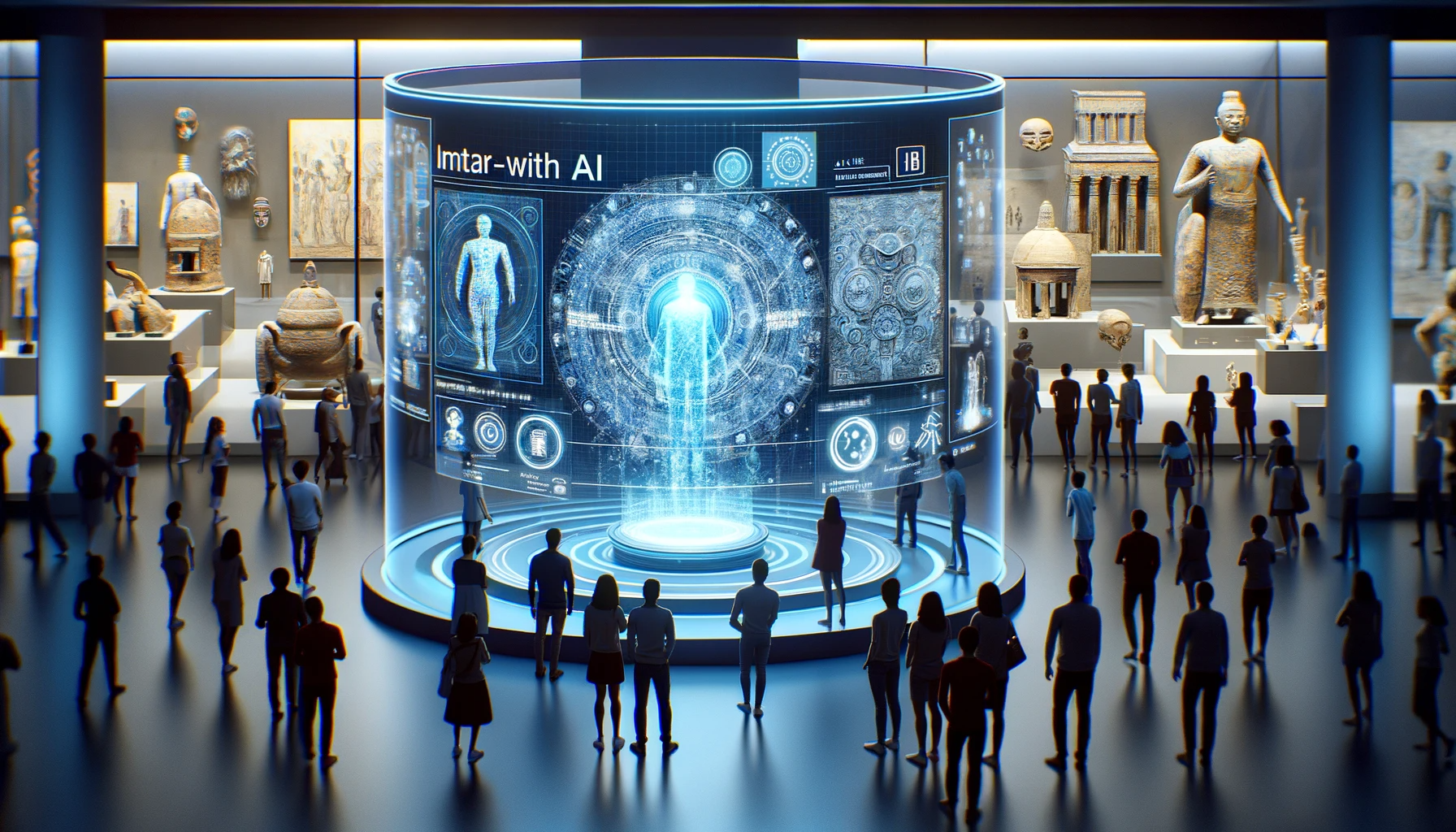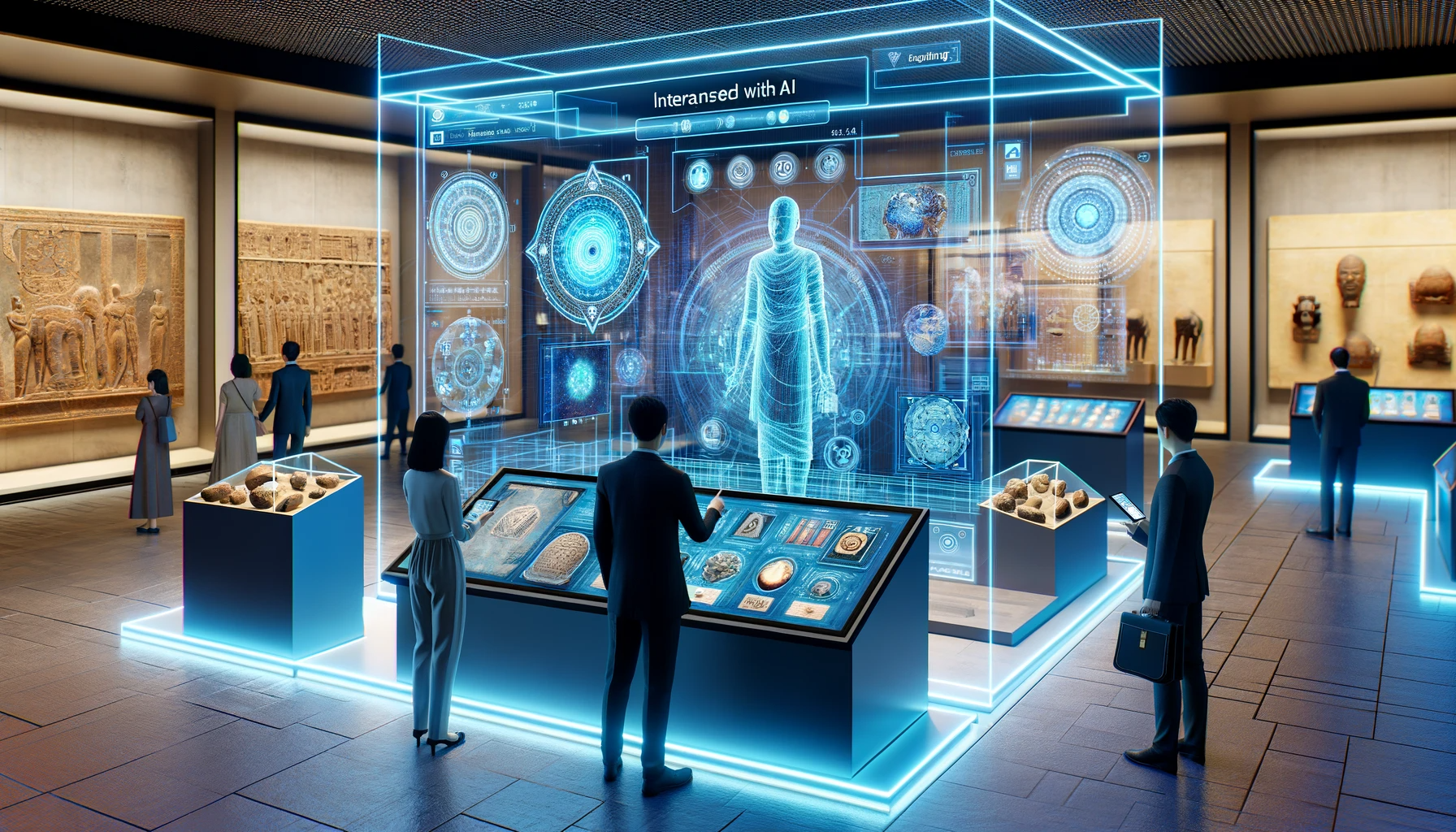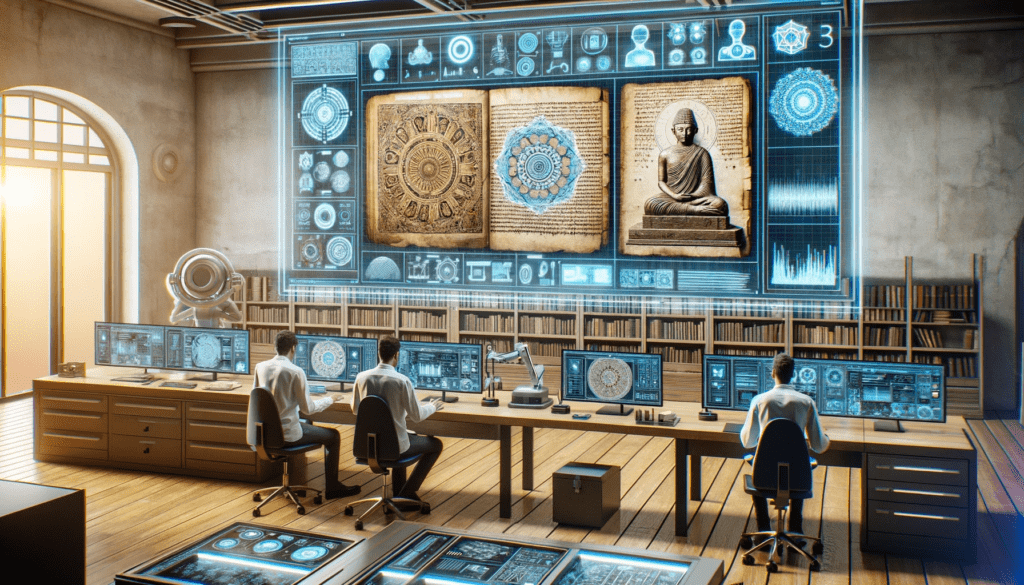Cultural heritage and history are the threads that weave the tapestry of human civilization. They encompass the art, artifacts, documents, and traditions that tell the story of our collective past. Yet, the preservation of these invaluable treasures faces a formidable challenge in the modern era. Natural disasters, vandalism, decay, and the ravages of time threaten to erase significant portions of our cultural legacy. However, as we stand at the intersection of tradition and technology, a new ally has emerged to safeguard these treasures: Artificial Intelligence (AI).
This article embarks on a captivating exploration of how AI is taking on the mantle of cultural heritage and history preservation. It delves into the ways in which this transformative technology is not only preserving but also reinvigorating the appreciation of our cultural legacy. From digitizing ancient manuscripts and restoring damaged artworks to monitoring and conserving historical sites, AI’s potential in this field is boundless.
Historical documents, the chronicles of our ancestors’ wisdom and experiences, are being painstakingly digitized and analyzed by AI algorithms. These digital libraries unlock previously hidden insights, ensuring that ancient knowledge remains accessible to future generations.
AI’s ability to restore and recreate lost artifacts is equally astonishing. From piecing together shattered sculptures to resurrecting paintings from the past, AI’s artistic capabilities are nothing short of remarkable.
Furthermore, AI doesn’t stop at conservation; it extends its reach to cultural heritage sites, employing sensors, drones, and predictive models to protect these treasures from environmental threats. It also opens the door to immersive cultural exploration through augmented and virtual reality experiences.
However, as we delve into AI’s contributions to cultural preservation, we must also navigate the ethical and cultural considerations that accompany these advancements. Balancing innovation with cultural sensitivity is paramount.
Join us on this captivating journey as we uncover the myriad ways in which AI is becoming the guardian of our cultural heritage, ensuring that the tapestry of history remains vivid and enduring for generations to come.
Digitizing and Analyzing Historical Documents
Historical documents serve as invaluable windows into the past, offering glimpses into the thoughts, knowledge, and cultures of bygone eras. However, the preservation of these documents presents numerous challenges, including the deterioration of paper and ink over time, the threat of natural disasters, and the sheer volume of historical texts scattered across the globe. AI is proving to be a formidable ally in addressing these challenges and ensuring that historical documents remain accessible and comprehensible.
One of the primary ways in which AI contributes to this preservation effort is through digitization. Advanced scanning technologies, coupled with machine learning algorithms, are used to create high-resolution digital copies of historical manuscripts, texts, and archives. These digital replicas not only protect fragile originals from further wear but also democratize access to historical documents by making them available online to researchers, scholars, and the public.
AI’s role extends beyond mere digitization; it delves into the realm of analysis and interpretation. Natural Language Processing (NLP) algorithms can decipher ancient scripts, languages, and dialects that may have been forgotten or require specialized expertise. This capability enables researchers to unlock previously inaccessible knowledge within historical texts.
Moreover, AI-driven translation tools are facilitating the understanding of texts written in languages that are no longer widely spoken. This is particularly crucial for preserving the cultural diversity found in historical documents.
For example, the use of AI in analyzing the Dead Sea Scrolls, ancient manuscripts written in Hebrew and Aramaic, has shed new light on the history of Judaism and early Christianity. AI algorithms have deciphered damaged and fragmented texts, enabling researchers to piece together a more comprehensive narrative of the past.
AI’s analytical prowess doesn’t stop at language. Machine learning models can recognize patterns, trends, and historical context within documents, providing historians with valuable insights. Whether it’s identifying recurring themes in literary works, tracking the spread of ideas through time, or detecting historical forgeries, AI is becoming an indispensable tool in the historian’s arsenal.
AI in Artifact Restoration and Reconstruction
The preservation of cultural artifacts poses a unique set of challenges. Time, exposure to the elements, and human actions can take a toll on these treasures, leading to damage, decay, or even loss. In such cases, AI emerges as a remarkable solution, offering innovative ways to restore and reconstruct these irreplaceable pieces of history.
AI’s foray into artifact restoration often involves cutting-edge technologies such as 3D scanning and machine learning. 3D scanning allows experts to create highly detailed digital models of damaged or deteriorated artifacts. These digital replicas serve as a foundation for the restoration process, providing a 360-degree view of the artifact’s current state.
Machine learning algorithms play a crucial role in understanding the artifact’s original form. By analyzing the digital model alongside historical references and similar artifacts from the same era, AI can infer the missing details, such as broken parts or faded colors. This aids in creating a more accurate representation of the artifact in its prime.
One notable example of AI in artifact restoration is the reconstruction of ancient statues and sculptures. AI algorithms can analyze existing fragments, identify the original features, and generate a digital blueprint for the missing parts. Skilled artisans can then use this blueprint to recreate the artifact with remarkable precision, breathing new life into centuries-old masterpieces.
Similarly, AI is instrumental in the reconstruction of damaged artworks and paintings. By analyzing the remaining brushstrokes, colors, and artistic techniques, AI can provide insights into the artist’s style and intent, aiding restorers in their efforts to return the artwork to its former glory.
AI’s contribution to cultural heritage extends beyond mere restoration; it encompasses the recreation of lost artifacts. In cases where an artifact has been completely destroyed or lost to history, AI can use historical records, descriptions, and artistic conventions to generate a digital replica or a physical reconstruction, ensuring that these cultural treasures are not lost to future generations.

AI for Cultural Heritage Conservation
Preserving cultural heritage is not limited to documents and artifacts; it also includes safeguarding historical sites, monuments, and architectural wonders that bear witness to the passage of time. These sites, however, face numerous threats, ranging from natural disasters to the gradual effects of environmental changes. AI is playing a pivotal role in monitoring, conserving, and protecting these heritage landmarks.
One of the key applications of AI in cultural heritage conservation is through remote sensing technologies. AI-driven sensors, including LiDAR (Light Detection and Ranging) and thermal imaging, are deployed to monitor the structural integrity of historical buildings and archaeological sites. These sensors can detect subtle shifts, cracks, or temperature changes that may indicate potential damage or deterioration.
Drones equipped with AI-powered cameras are increasingly used to capture high-resolution aerial imagery of heritage sites. These images provide invaluable insights into the condition of historical structures and landscapes, helping experts identify areas in need of maintenance or restoration.
Furthermore, AI algorithms can process and analyze data from remote sensors and drones in real time, enabling swift response to emerging threats. For example, if a heritage site is at risk of flooding or erosion due to changing weather patterns, AI can trigger automated alerts and preventive measures, such as reinforcement of vulnerable areas or temporary barriers.
Predictive modeling is another application of AI in heritage conservation. By analyzing historical data, environmental factors, and site-specific conditions, AI can forecast potential risks to cultural heritage, allowing for proactive strategies to mitigate these risks. This predictive capability is especially crucial in regions prone to natural disasters like earthquakes, floods, or wildfires.
In essence, AI is becoming a guardian of cultural heritage, providing continuous monitoring and data-driven insights that empower conservationists and authorities to protect these irreplaceable treasures. This blend of technology and cultural preservation ensures that our historical sites and monuments stand the test of time and continue to inspire awe and reverence in generations to come.
Augmented Reality and Virtual Reality (AR/VR) for Cultural Exploration
The fusion of Artificial Intelligence (AI) with Augmented Reality (AR) and Virtual Reality (VR) technologies is ushering in a new era of cultural exploration and understanding. These immersive experiences enable individuals to step into the past, virtually visit historical sites, and engage with cultural artifacts in ways never before possible.
AI plays a pivotal role in enhancing AR and VR experiences by providing context, information, and interactive elements that enrich the user’s understanding. Here’s how AI is transforming cultural exploration:
- Contextual Information: AI-powered AR and VR applications can provide real-time contextual information about historical sites and artifacts. As users explore a museum or historical location through AR glasses or VR headsets, AI algorithms can recognize objects and provide historical background, stories, and details related to what they see.
- Guided Tours: AI-driven virtual guides lead users on immersive tours, providing insights and historical context as they navigate through virtual recreations of historical settings. These guides adapt to users’ interests and questions, enhancing the educational experience.
- Language Translation: Language barriers are no longer a hindrance to cultural exploration. AI-powered AR apps can offer real-time translation of signs, inscriptions, and spoken content, allowing users to engage with cultural heritage in their preferred language.
- Interactive Experiences: AI-driven simulations and interactive elements within VR environments enable users to interact with historical figures, experience events from the past, or even participate in historical reenactments. These experiences foster a deeper connection to history.
- Accessibility: AI ensures that AR and VR experiences are accessible to individuals with various abilities. Text-to-speech and speech-to-text capabilities, coupled with AI-driven gestures and voice commands, provide inclusive experiences for all.
The impact of AI-enhanced AR and VR in cultural exploration extends to education, tourism, and entertainment. These immersive technologies are not only engaging but also foster a profound appreciation for history and cultural heritage. By bridging the gap between the past and the present, AI-driven AR and VR experiences empower individuals to become active participants in preserving and understanding our shared history.
Challenges and Ethical Considerations
As AI takes on a more prominent role in cultural preservation and exploration, it brings forth a set of challenges and ethical considerations that must be addressed:
- Cultural Sensitivity: AI algorithms may inadvertently perpetuate biases or stereotypes when interpreting historical texts or artifacts. It is crucial to ensure that AI-driven analyses and descriptions are culturally sensitive and respectful.
- Data Privacy: The collection of user data in AR and VR experiences raises concerns about data privacy. Users’ interactions and preferences within these immersive environments should be safeguarded to prevent misuse.
- Ownership and Repatriation: AI may be used to digitize and analyze artifacts that have complex ownership histories. Ethical questions arise regarding the repatriation of cultural artifacts to their places of origin and the use of AI in such decisions.
- Accessibility and Inclusivity: While AI can enhance accessibility, there are challenges in making AR and VR experiences universally accessible to individuals with disabilities. AI developers must prioritize inclusivity in design.
- Historical Accuracy: AI-driven reconstructions of historical artifacts and sites must strive for historical accuracy. Misrepresentations or inaccuracies can distort historical narratives and perceptions.
- Digital Preservation: The long-term preservation of digitized content is essential to ensure that future generations can access historical records and artifacts. AI plays a role in data archiving and maintaining digital assets.
Addressing these challenges and ethical considerations requires collaboration between AI developers, cultural institutions, historians, and ethicists. Ethical guidelines, transparency in AI algorithms, and user consent are critical components of responsible AI implementation in cultural preservation and exploration.
Case Studies and Success Stories
The impact of AI in cultural heritage preservation and exploration is best exemplified through case studies and success stories:
- The Louvre and VR: The Louvre Museum in Paris has embraced AI-enhanced VR experiences, allowing visitors to explore the museum’s extensive collection virtually. AI algorithms provide detailed information about artworks and historical context, enhancing the visitor’s understanding and appreciation.
- Google’s Art & Culture: Google’s Art & Culture platform uses AI to provide users with virtual access to artworks, historical documents, and cultural artifacts from museums and institutions worldwide. It employs AI for image recognition, translation, and art analysis, enriching the online cultural exploration experience.
- CyArk’s Preservation Initiatives: CyArk, a nonprofit organization, combines AI and 3D scanning to digitally preserve cultural heritage sites and monuments. Their work includes the digital documentation of historic locations threatened by natural disasters, enabling future generations to virtually explore and study these sites.
- British Museum and AI Translation: The British Museum partnered with AI researchers to develop an AI-driven system that can translate and interpret ancient inscriptions and texts from different cultures. This technology enhances the understanding of artifacts and facilitates cross-cultural research.
These case studies demonstrate how AI is actively contributing to cultural preservation and exploration, making cultural heritage more accessible and engaging for a global audience.

Future Prospects and Conclusion
As we gaze into the future, the synergy between AI and cultural heritage preservation and exploration holds immense promise. AI will continue to refine its capabilities, providing increasingly accurate translations, more realistic reconstructions, and deeper historical insights. The democratization of cultural heritage, through accessible AR and VR experiences, will foster a sense of global interconnectedness and appreciation for diverse cultures.
However, it is imperative that we tread carefully, mindful of the ethical considerations and potential pitfalls that accompany AI in this field. Responsible AI development, guided by ethical principles, will ensure that AI remains a force for good in the preservation of our shared cultural heritage.
In conclusion, AI is becoming an indispensable partner in the mission to safeguard and celebrate our cultural legacy. By combining the power of technology with the richness of history, we are embarking on a journey that transcends time and space, ensuring that the treasures of our past continue to inspire and educate generations to come.
